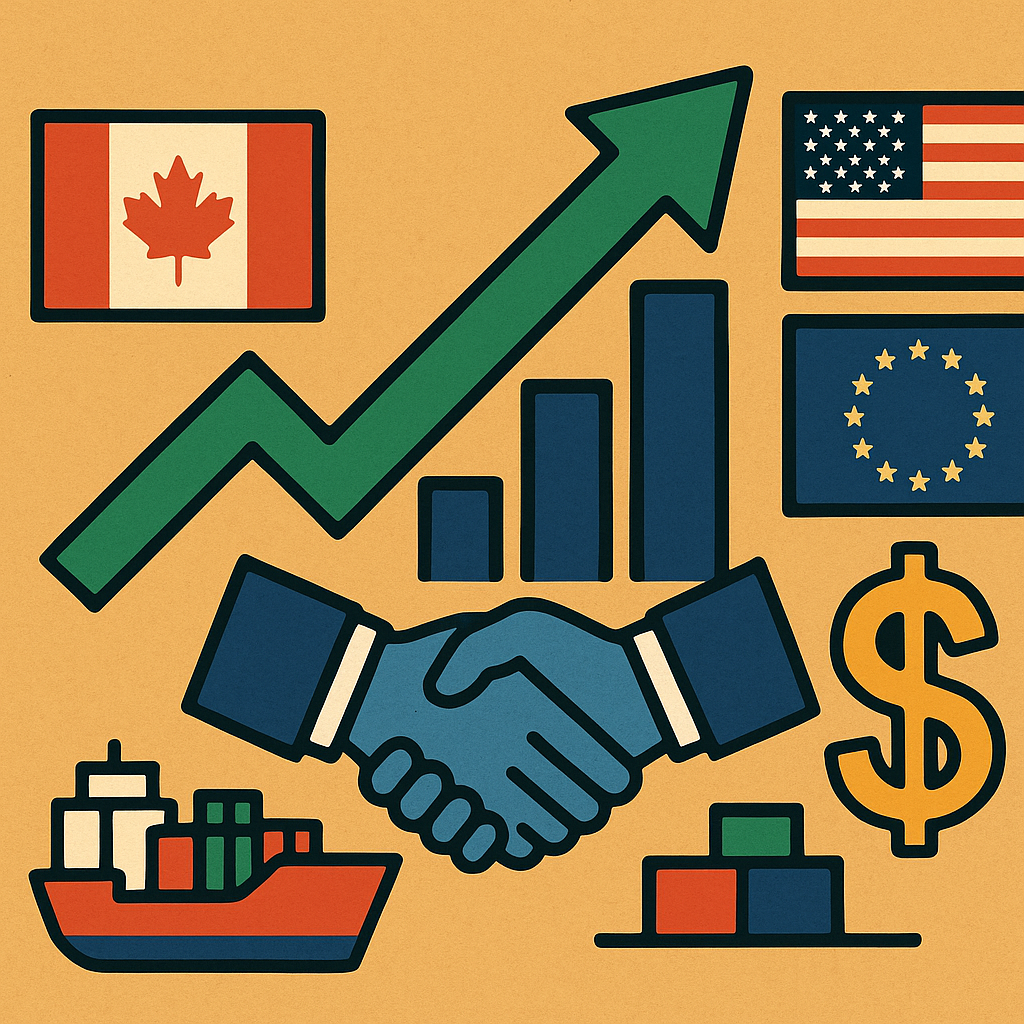A fresh wave of trade optimism is nudging Canadian markets upward. On July 21, the S&P/TSX futures rose roughly 0.2%, buoyed by growing expectations that the United States and European Union may finalize a new trade agreement aimed at reducing tariffs and unlocking cross-border growth. While modest in scope, the move is gaining traction among investors watching the ripple effects for Canada—particularly with the looming August 1 U.S. tariff deadline hanging over North American trade.
With Canada’s economy heavily tied to global trade and commodity exports, even incremental shifts in global tariff negotiations can significantly sway investor sentiment. For many, this morning’s futures uptick signals cautious optimism that Canada could emerge as a key beneficiary of shifting international trade winds.
Exporters in Focus as Trade Winds Shift
The TSX’s upward move, though small, arrives at a pivotal moment. According to Reuters, the renewed trade momentum between the U.S. and EU could offer indirect relief to Canada’s export-heavy sectors—including energy, agriculture, manufacturing, and metals—many of which have been weighed down by rising geopolitical risk and recession fears.
Canada’s economy is particularly sensitive to external demand. Over 64% of Canada’s GDP is tied to exports, with the U.S. accounting for roughly 75% of all Canadian exports, according to Statistics Canada. That heavy reliance puts the country squarely in the spotlight as the U.S.–Canada–Mexico Agreement (USMCA) undergoes renewed scrutiny, especially ahead of the potential U.S. tariff adjustments on August 1.
Markets are already pricing in the possibility that improved U.S.–EU ties may reduce trade friction globally, setting the stage for Canada to expand its export reach and sidestep collateral damage from larger trade battles.
Why This Matters for Investors
Trade policy isn’t just politics—it’s pricing power, sector rotation, and risk rebalancing. Investors with Canadian exposure should closely monitor sectors that are highly trade-sensitive:
- Energy producers may benefit from increased U.S. and European demand if tariffs ease and global supply chains stabilize.
- Industrial firms, especially those in machinery and transport, stand to gain from resumed trade flows.
- Agribusiness stocks could rally as food exports find new buyers in a less restrictive global landscape.
According to RBC Economics, “every percentage point increase in global trade growth adds 0.3 to 0.5 percentage points to Canada’s GDP,” making this optimism more than just symbolic.
Market Reactions & Currency Impact
While the TSX futures ticked up slightly, the Canadian dollar (CAD) also saw light strengthening against the U.S. dollar, reflecting increased investor confidence in Canada’s near-term trade outlook.
Global fund managers are reportedly rotating into Canadian financials and exporters, anticipating tariff relief and fresh demand pipelines. ETF flows into iShares S&P/TSX 60 Index ETF (XIU.TO) and BMO Equal Weight Global Base Metals ETF (ZMT.TO) are also showing moderate volume increases, according to Bloomberg Terminal data.
At the same time, investors are keeping a close eye on Bank of Canada signals, particularly as it prepares to release its business outlook survey next week. This will offer a timely gauge of how domestic executives perceive international trade developments.
Future Trends to Watch
Several potential catalysts could amplify or undercut today’s momentum:
- August 1 U.S. Tariff Decision: A new round of tariffs—especially on vehicles, steel, or tech—could reverse sentiment quickly.
- EU–Canada Trade Synergies: If the U.S.–EU deal materializes, it could encourage a revitalization of Canada’s CETA (Comprehensive Economic and Trade Agreement) usage, which has remained underutilized.
- Supply Chain Diversification: Companies continuing to “China-plus-one” their sourcing strategies may favor Canadian partners as lower-risk Western alternatives.
Trade is no longer just about goods crossing borders—it’s about capital allocation, competitive positioning, and market access. Canada’s ability to stay trade-resilient amid shifting geopolitical winds will be a critical theme for the remainder of 2025.
Key Investment Insight
Canada’s role as a stable, resource-rich trading partner positions it well in a world seeking geopolitical balance and diversified supply chains. Investors may consider increasing exposure to Canadian exporters, industrials, and commodities, especially those poised to benefit from renewed U.S. and EU demand.
Also, keep a close watch on trade-sensitive ETFs and sectors like mining, agriculture, and mid-cap manufacturing, as they often lead the way in early-cycle global trade recoveries.
Get real-time market-moving insights every day with MoneyNews.Today—your go-to destination for actionable financial news, trend analysis, and investor intelligence that cuts through the noise.





